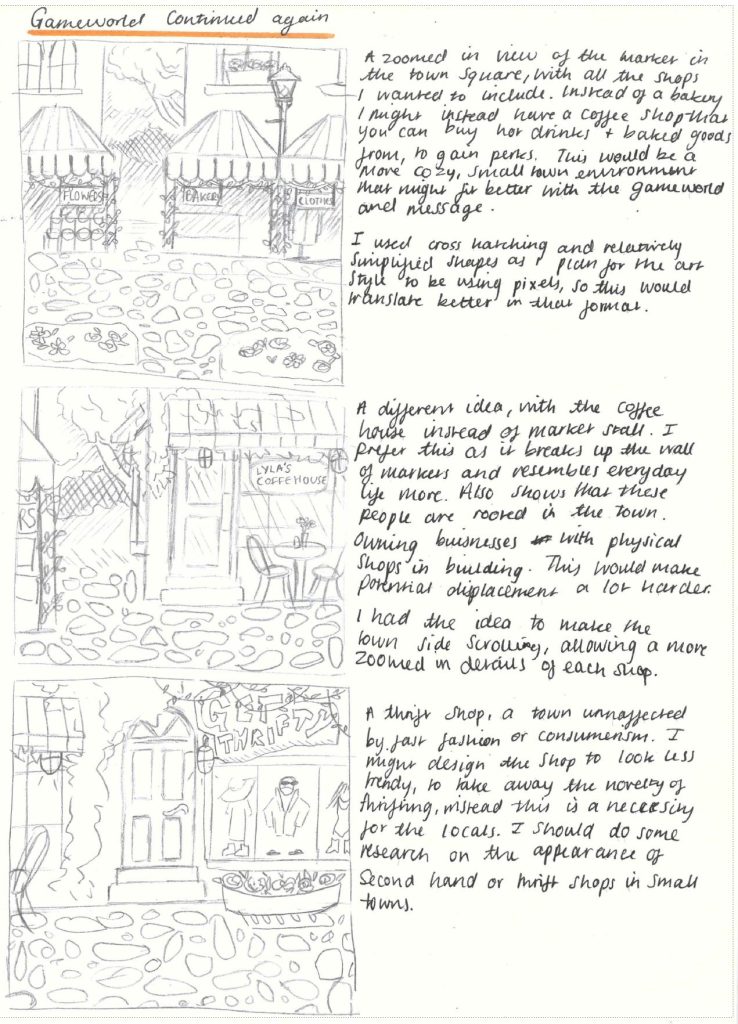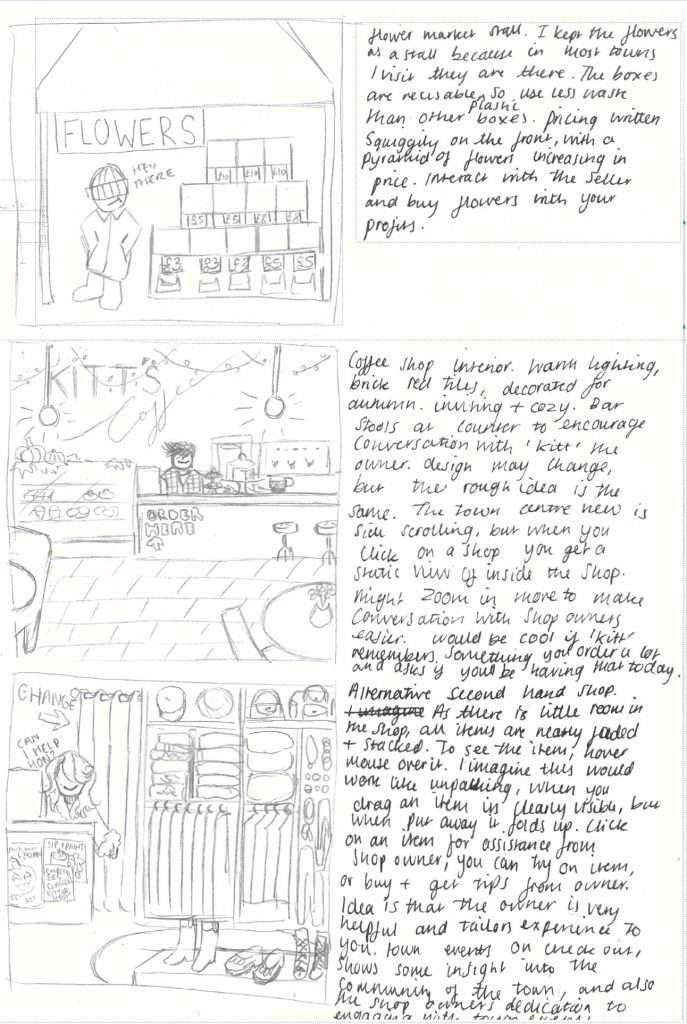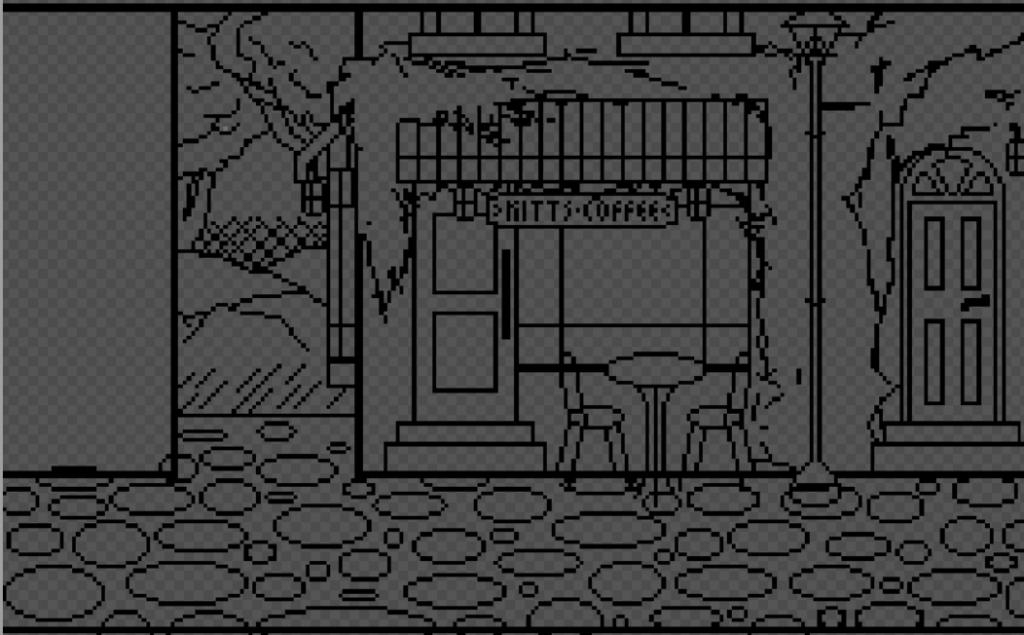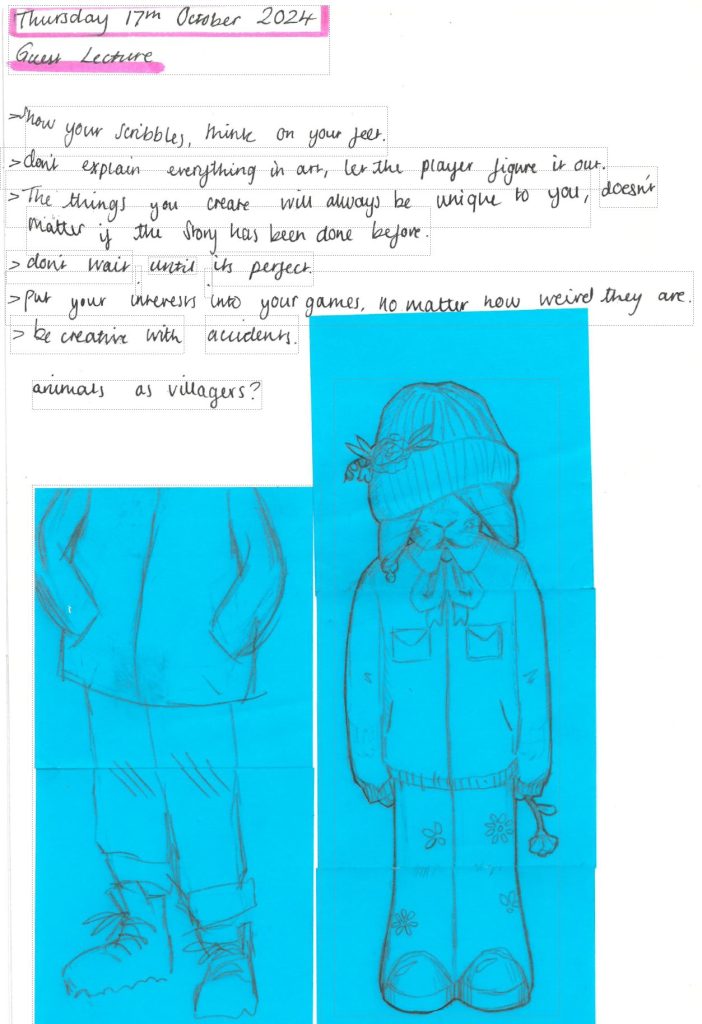This week I tried to focus on integrating my essential experiences into my game world.
Lecture notes – Articulating your essential experience
Every choice has a clear design intention – they all relate to the essential experience. Dig deeper into the reasoning behind your game decision, why do I want to make the game and why are the things the way they are in the game? What do I know or assume about that topic? What do I know and what do I need to find out?
How can I capture this experience via games design?
Play Structures:
My game would combine skill-based, rule-bound structures with role-playing, socially-negotiated structures. My essential experience is more supported by a role-playing game structure, but as with real life, it needs to be supported by rules and limitations. (Agon and Mimesis).
Aesthetics: what applies to my game is in bold.
- 1. Sensation game as sense-pleasure – I want players to wind down while playing.
- 2. Fantasy game as make-believe
- 3. Narrative game as drama – My game will have a set narrative with conflicts and resolutions.
- 4. Challenge game as obstacle course – Part of my gameplay will challenge the player.
- 5. Fellowship game as social framework – Communication with NPC’s will be important.
- 6. Discovery game as uncharted territory
- 7. Expression game as self-discovery – Part of my game will allow players to dress as they like.
- 8. Submission game as pastime
Elemental Triad:
- Mechanics (rules, procedures, game loop): Florist gameplay, when during gameplay can you explore the world, market and outer world.
- Aesthetics (look and feel): Cosy, autumnal, warm and inviting.
- Story (sequence of events): Things start well and slowly change, people in town have their own story.
- Technology (enables the experience): Digital art platforms e.g. Piskel, programming the gameplay.
Zooming into the game world: Town Square
To capture the essence of the world I wanted to create, I had to do some thumbnail drawings. I first focused on working out the town square, as I had a strong idea on how it should look. I decided I wanted 3 shops available to buy goods from in the town square; The flower shop, the coffee shop/ bakery, and a clothes shop. The florist/player would need to use the flower shop to buy flowers for their floristry work/gameplay. I had the idea that consumable goods from the coffee shop could give the player perks when working. The clothing shop would allow players to customise their character. Each business would be independently owned, and each shop owner would have their own story, personality and motives for the work they do. The player could get to know each business owner through dialogue and optional conversations. This would hopefully create the feeling of a living, tightknit community, as well as providing me with an opportunity to focus on the challenges of owning small businesses. Here are my drawings, and my reflections on each design:

I used the photos I took of Winchester as references for the town design, especially the market stalls. The flower stall design is nearly Identical to the one in the photos I took. The street lamp and cobbled stone floor also represents the old town feel. The coffee shop was intended to have a romantic, Parisian look with a warm glow emitting from the windows and lanterns.

For the coffee shop interior, I took inspiration from Luke’s Diner from Gilmore Girls. The diner has bar stools at the counter, coffee jugs for free refills, and cakes on trays. A no cell phone sign is also hung in the shop, because of Luke’s distain for technology. This encourages more face-to-face conversation, although as Kitt is a calmer character than Luke, I didn’t think that sign suited the coffee shop.
The thrift shop is quite different to your average clothes shop. All pieces are second hand, and are stacked efficiently on shelves due to the lack of space in the shop. This helps the player to see all its contents and categories easily. To help see each item, I thought it would be cool to have the items unfold, coming into full view as the player hovered their cursor over them. I though the game ‘Unpacking’ did this effectively, so I took inspiration from that.
Environmental storytelling: There are some small details in the sketches that hint to a bigger story. The thrift shop owner advertises town events in her shop, events which will be held in game. This shows her passion for and involvement within the community. It also serves as a reminder to players when festivals will occur, if they choose to be involved. These posters could change throughout gameplay as the seasons change. Kitt also decorates his coffee shop depending on the season. This is a testament to his enthusiasm in making his shop have character and feel inviting to customers.
Photo inspiration for the town square

Here are some pictures that show the desired look of the town and shops. I think some of the images are AI but they showcase the orange glow that I imagined coming out of the windows. The pyramid of flowers can be seen in the photo I took of the Winchester flower market, I even made sure to capture the fairy lights.
Pixel work-in-progress
I started working on a finished iteration of the town square using pixel art. I decided to use Piskel for my artwork as it is easy to create simple animations on this platform. Having the world ‘twinkle’ slightly will enhance the warm, cosy feel I want to share with players. The world will seem ‘alive’ like it is it’s own character in the story. I took inspiration from my mood boards and photography, pasting in small details to fill the scene with charm and focal points. The view of the town is centred on Kitt’s Coffee, but will side-scroll left and right to show the views of the other shops. The player sees the shops from the main characters point of view, so the player won’t run around in-world, but instead use the arrows to move sideways, and the cursor to click on the shop they wish to enter.

Guest lecture – Moving onto character design
In Thursdays lecture we started looking into character design. I had a few ideas of some characters already from designing my shops, as I had to consider who might own them. I wrote down some advice from the guest speaker and felt inspired to draw a potential character design of the flower market owner. I had an idea that my characters could be animals to bring another point of interest to the world. I will explore character creation further in week 4!

End of week 3!
Reply